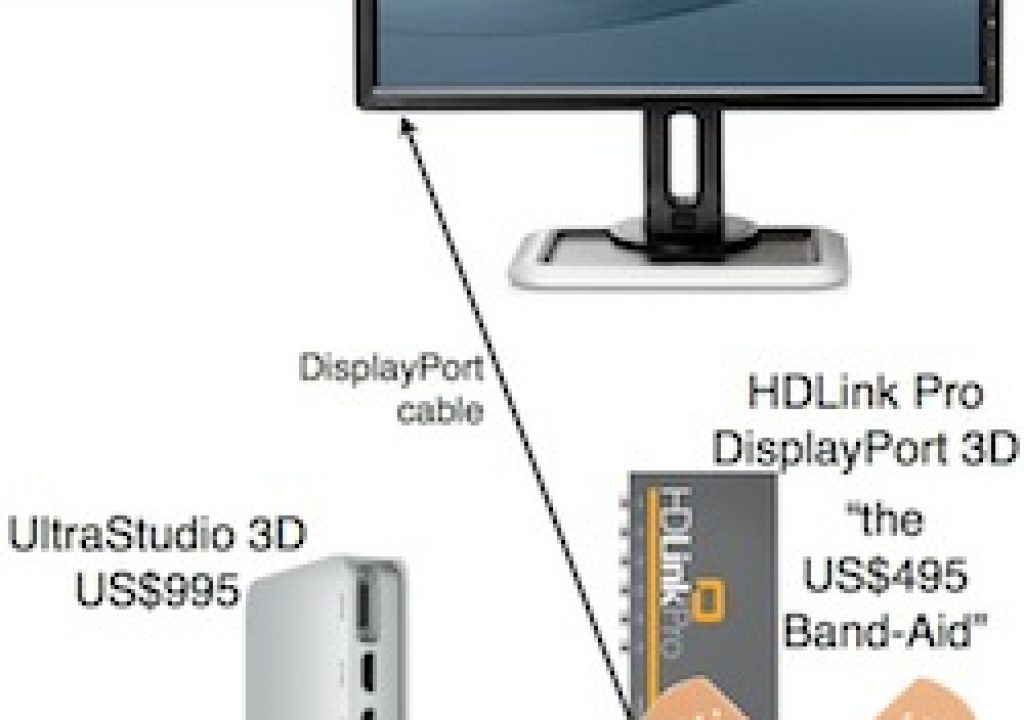Back in May 2012, I created an online petition directed at Blackmagic. Why did I do that? Because despite years of diplomatic prodding on my part, both via articles in ProVideo Coalition magazine and private emails, Blackmagic had (and has still) avoided and postponed offering RGB on its HDMI outputs. [If you’ve read my articles regarding HP DreamColor connectivity, you already know that the DreamColor engine demands digital RGB (not YUV/component) and true progressive (not interlaced or even PsF).]
As a result, until Blackmagic updates their products (hopefully via a firmware and software update), you’ll still have to spend an additional US$495 for an HDLink Pro 3D DisplayPort which will take the SDI signal from your interface and deliver pure RGB progressive to the DreamColor monitor. And that also means an additional SDI cable, an additional power supply, an additional power outlet, and having to make additional adjustments in another device. Back in May 2012, I created an online petition for people to make their public request to Blackmagic. The petition recently surpassed its original goal, and as I publish this article has reached 204 signatures.
The last time I contacted Blackmagic about this issue was just after NAB in April 2012. The answer I received from Blackmagic’s US public relations department via email was that it would only offer RGB over HDMI “at 1080p60” and from an RGB/4:4:4 timeline as a source. As you probably know, 1080p60.000 is a non-standard signal, since standard progressive signals include :
- 1080p23.976
- 1080p24.000
- 1080p25
- 1080p29.97
- 1080p50
- 1080p59.94
It is certainly possible that Blackmagic’s public relations department (or their internal source) was simply rounding 59.94 to 60 when responding to me. Even so, we really want to send the exact matching framerate of the timeline to the monitor. We absolutely don’t want it cross-converted to 59.94 or 60.000 when the timeline is at one of the other framerates. And although everything in a grading program may be transcoded to RGB upon import, that’s not typically the case with video editing software. As stated in several prior articles, AJA and Matrox have all added this capability, which transcodes the YUV (component) to RGB on-the-fly when necessary after the user has selected to force RGB on the HDMI output. I have no idea whether Blackmagic is avoiding adding this digital RGB-over-HDMI feature to their interfaces on purpose to force users to buy the additional US$495 “Band-Aid” (the HDLink Pro 3D DisplayPort), whether they have simply been busy with other things, or whether it has been an extended oversight.
Why do I like the HP DreamColor so much?
The short answer is because the HP DreamColor is by far the lowest cost 10-bit LCD critical evaluation monitor with the following included:
- Beyond CRT gamut
- Color temperature set by adjusting LED backlight, not by manipulating the video signal
- Inexpensive dedicated colorimeter with software for Mac & Windows (both from HP) and for Linux (open source version)
- ITU-R Rec.601 color space for SD video
- ITU-R Rec.709 color space for HD video
- DCI P3 color space for digital cinema
- Adobe RGB
- sRGB
- Custom profiles for atypical client situations
- For pro video applications, all profiles are stored in the monitor, not in the computer
- IPS (In Plane Switching) panel = extremely high contrast ratio even at very indirect angles (off-axis)
- Matte panel (not reflective)
- True 30-bit (10-bit per each subpixel x3) panel, which means full color, and no banding or dithering
- Very low black level (CRT class)
For the long answer, see the links to related articles ahead in this article.
The petition for Blackmagic to update this via firmware & software
Back in May 2012, I created an online petition. It remains to be seen when Blackmagic will finally appease its users. In the meantime, feel free to continue to sign it.
Related DreamColor articles
- Allan Tépper's: Does Premiere CS5 achieve the “impossible dream” for critical evaluation monitoring?
- Allan Tépper's: Why should I care if my monitor shows ITU Rec.709?
- Allan Tépper's: Who is the ITU, and why should I care?
- Allan Tépper's: How to connect your HD evaluation monitor to your editing system properly: Let me count the ways!
- Allan Tépper's review: DreamColor from HP: an ideal tool for critical image evaluation
- Patrick Inhofer's review: HP's DreamColor: A PVM CRT Replacement?
- Allan Tépper's: DreamColor direct interfaces
- Allan Tépper's: DreamColor converter boxes for non-compliant systems
- Allan Tépper's: Matrox's original MXO crashes the Direct DreamColor interface party
- Art Adam's: GEEK OUT: The Non-Technical Technical Guide to Sony OLED Monitors
- Allan Tépper's Bandito Brothers use multiple HP DreamColors + Adobe Premiere for Act of Valor
Upcoming articles, reviews, and books
Stand by for upcoming articles, reviews, and books. Sign up to my free mailing list by clicking here.
Si deseas suscribirte a mi lista en castellano, visita aquí. Si prefieres, puedes suscribirte a ambas listas (castellano e inglés).
FTC disclosure
No manufacturer is specifically paying Allan Tépper or TecnoTur LLC to write this article or the mentioned books. Some of the other manufacturers listed above have contracted Tépper and/or TecnoTur LLC to carry out consulting and/or translations/localizations/transcreations. Many of the manufacturers listed above have sent Allan Tépper review units. So far, none of the manufacturers listed above is/are sponsors of the TecnoTur programs, although they are welcome to do so, and some are, may be (or may have been) sponsors of ProVideo Coalition magazine. Some links to third parties listed in this article and/or on this web page may indirectly benefit TecnoTur LLC via affiliate programs.
Copyright and use of this article
The articles contained in the TecnoTur channel in ProVideo Coalition magazine are copyright Allan Tépper/TecnoTur LLC, except where otherwise attributed. Unauthorized use is prohibited without prior approval, except for short quotes which link back to this page, which are encouraged!

